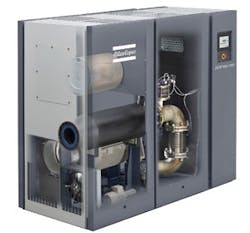New Blower System Promises Improved Energy Efficiency
In a typical biological wastewater treatment plant, the aeration blower system alone accounts for up to 70 percent of the energy usage. A new line of energy-efficient blowers has been developed to help lower energy-related costs for water treatment.
Atlas Copco recently introduced a new line of ZS screw blowers. In third-party independent testing the new blowers were shown to average 30 percent more energy-efficient operation than conventional lobe blower technology.
The oil-free screw blower is a positive displacement machine that pairs male and female rotors. The air is compressed as the available volume between the two rotors decreases with each rotation. At the beginning of the compression cycle, air at the inlet fills the flute space and becomes trapped. The air is then continually compressed internally as the male and female parts mesh with each revolution until it is pushed through the discharge outlet.
Because the air is compressed internally, the discharge volume is smaller than the suction volume and less energy is needed to supply the compressed air to an aeration tank. Less energy means the screw blower operates with greater efficiency than rotary lobe blowers.
Atlas Copco's new line of ZS screw blowers are said to be an average of 30 percent more energy-efficient than conventional lobe-style blowers.
To compare the performance of a rotary lobe blower versus the new screw blower, the two blowers were tested in the same environment under equal operating conditions. The energy consumed by each machine was measured at the power source, as was the flow levels at each machine's respective outlet.
In one set up, a tri-lobe rotary blower was sized with a 110 kW motor and connected to a separately installed frequency converter. For comparison, an oil-free screw blower was fitted with a 75 kW motor with an integrated frequency drive. The resulting measurements taken at maximum volume flow showed that the rotary lobe displacement blower consumed 141.0 kW compared to the screw blower's usage of 106.7 kW, or about 32 percent more energy.
Additional testing conducted by the Technische Überwachungs-Verein (German Technical Monitoring Association, or TÜV), an independent, third-party organization, compared the performance of the screw blower against a tri-lobe blower. Test results showed that the screw blower is 23.8 percent more energy-efficient than a tri-lobe blower at 7 psig, and 39.7 percent at 13 psig.
As a side benefit, the new screw blowers are also much quieter, operating at 75 dBa versus 85 to 90 dBa for rotary lobe blowers. Occupational Safety and Health Administration (OSHA) mandates that employers must administer a hearing conservation program for employees who experience occupational noise levels that reach or exceed eight-hour periods of exposure to 85 dBa. No special precautions to safeguard employee exposure below this level are mandated. WW
More WaterWorld Current Issue Articles
More WaterWorld Archives Issue Articles

